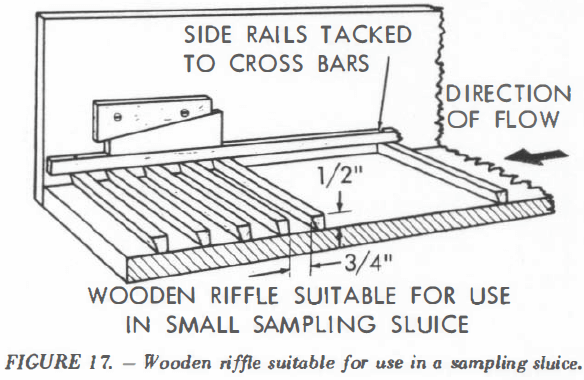

- #SLUICE BOX RIFFLE ANGLE HOW TO#
- #SLUICE BOX RIFFLE ANGLE PDF#
- #SLUICE BOX RIFFLE ANGLE FULL#
- #SLUICE BOX RIFFLE ANGLE PRO#
Google has not performed a legal analysis and makes no representation as to the accuracy of the status listed.) Expired - Lifetime Application number US97046A Inventor Adcock Oliver Original Assignee Adcock Oliver Priority date (The priority date is an assumption and is not a legal conclusion.
#SLUICE BOX RIFFLE ANGLE PDF#
Next, air dry your gold or heat it slowly outdoors in a metal pan.- Google Patents US1597705A - Sluice box or riffleĭownload PDF Info Publication number US1597705A US1597705A US97046A US9704626A US1597705A US 1597705 A US1597705 A US 1597705A US 97046 A US97046 A US 97046A US 9704626 A US9704626 A US 9704626A US 1597705 A US1597705 A US 1597705A Authority US United States Prior art keywords riffle pockets sluice box trough sluice Prior art date Legal status (The legal status is an assumption and is not a legal conclusion. Do this several times to remove all traces of soap. After you see your gold gleam, be sure to rinse with clean water. The more gold you clean at one time, the faster if shines up because of the friction caused by shaking. How quickly you'll see a glittery shine often depends on how much gold is in the container.
#SLUICE BOX RIFFLE ANGLE FULL#
The best way to clean gold is to place it in a small water-tight container about half full of water and add a bit of dishwashing liquid. Sometimes placer gold comes out of a stream with a thin coating of mercury or other impurity attached to it, so it is necessary to clean your gold to bring out its natural luster and shine.
#SLUICE BOX RIFFLE ANGLE PRO#
With just a little practice, you'll be a pro at using a sluice in no time! Pre-classified material will run through the sluice at a more uniform rate. You may find that it helps to screen the material before you put it into the sluice by first passing the material through a gold classifier. The concentrates of heavier material and gold are now in the tub so that you can remove the gold from the concentrates with a gold pan or a Gold Cube or a spiral panning machine, or another clean up tool. Replace the carpet or miners moss and riffle tray into the sluice and you are ready to go again. Wash as much material as possible out of the sluice into the tub and then remove the riffle tray and carpet and wash both of them out into the tub. When you are ready to clean out the concentrates, remove the sluice from the water and tip it down into a bucket or tub. Pace your shoveling so that the sluice has time to clear before you add more material. Do not overload the sluice with material. Shovel material into the sluice at the flared end as close to the end as possible so that the material is washed over the entire length of the sluice. The higher the volume of water available, the shallower the angle will be. The sluice should be set at a downhill angle that allows the material to briskly flow through the sluice. If the current is strong you may need to lay some stones against the edge of the sluice to keep it from washing away. Place the sluice in the flow of a stream or river so that the water enters the flared end and flows through the sluice.
#SLUICE BOX RIFFLE ANGLE HOW TO#
Click here for Power Sluices / Highbankers.įor tips on how to properly set up and use a stream sluice, scroll to the bottom of this page. The non-motorized sluices below are made by Jobe, Tee-Dee, Le Trap, RDH Prospecting, Gold Buddy and are all considered hand sluices.

A steeper grade may result in all but the coarsest gold being carried away by the force of the water. At least start here, and adjust as needed. Since gold is heavy, it will stay in the bottom of the sluice, trapped in the miner's moss.Ī good rule of thumb is to set your sluice at a grade of one inch per foot of drop. The idea is to position a sluice box in a running stream so that the water does the work- separating the dirt and rocks away from the gold. Nineteenth century gold miners used wooden sluices that were at least 12 feet long, but modern gold prospectors primarily use sluice boxes made of plastic or metal which are typically 24, 36 or 48 inches long and 6 to 10 inches wide. Riffles are purposeful obstructions which slow the movement of gold in the sluice so it can be trapped in miner's moss, carpeting, or rubber matting in the bottom of the sluice. Sluicing is a method of separating and recovering gold from the placer gravel by the use of running water. Sluices are long, narrow "boxes" that water passes through when put in a creek or stream.


 0 kommentar(er)
0 kommentar(er)
